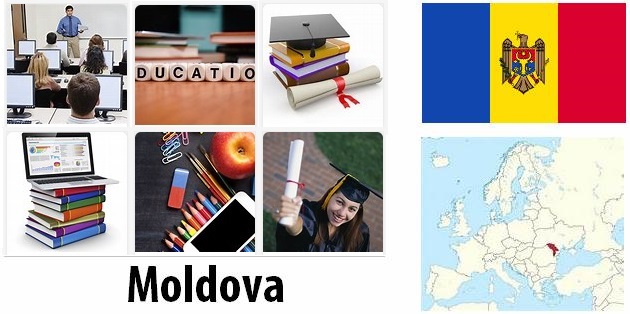Moldova – education
The school system plays a major role in building the country’s independence. From the early 1990’s, education has been oriented towards Romanian rather than towards Soviet-Russian conditions, and Moldovan has replaced Russian as the language of instruction.
The public school system includes a compulsory ten-year primary school for 6-16-year-olds, while further education takes place at the country’s 53 technical colleges and nine higher education institutions, including the country’s university (1997).
OFFICIAL NAME: Republic of Moldova
CAPITAL CITY: Chisinau
POPULATION: 4,470,000 (Source: COUNTRYaah)
AREA: 33,700 km²
OFFICIAL LANGUAGE (S): the Romanian dialect Moldovan, Ukrainian, Russian, others
RELIGION: Moldovan Orthodox 65%, Russian Orthodox 10%, Catholics 2%, Protestants 2%, Jews 2%, others 19%
COIN: leu
CURRENCY CODE: MDL
ENGLISH NAME: Moldova
INDEPENDENCE: 1991
POPULATION COMPOSITION: Moldovans 65%, Ukrainians 14%, Russians 13%, Gagus 4%, Bulgarians 2%, others 2%
GDP PER residents: 429 $ (2007)
LIFE EXPECTANCY: men 65 years, women 72 years (2007)
INDEX OF LIVING CONDITIONS, HDI: 0.694
INDEX OF LIVING CONDITIONS, POSITION: 114
INTERNET DOMAIN NAME: .md
Moldova is a republic in south-eastern Europe on the rivers Prut and Dniester, an ancient border country with cultural and economic ties to Romania, Russia and Ukraine; In 1940-91, the Moldovan Soviet Republic was part of the Soviet Union. In the context of ethnic-national strife over independence, the eastern part of the country seceded under the name of the Dniester Republic. The conflict remains unresolved, and thus, as of 2006, the Moldovan government does not have sovereignty over the entire territory of the state. The country is one of Europe’s poorest and corruption is widespread. The IMF provides loans to combat poverty, but the country has difficulty meeting the conditions. The World Trade Organization (WTO) took over Moldova in 2001.
- AbbreviationFinder.org: Find two-letter abbreviation for each independent country and territory, such as MD which stands for Moldova.
Moldova – Constitution
In 1994, the Republic of Moldova got its first post – Soviet constitution. Its purpose was to secure and develop the country’s ethnic and linguistic identity, as well as to establish the country’s permanent neutrality. Legislative power lay with the 104 members of parliament, who were elected for four years by direct election. The president, who was elected for a four-year term by direct election, shared executive power with the government, which was headed by a prime minister.
In 2000, Parliament adopted a series of amendments to the Constitution, which entailed an increase in Parliament’s power at the expense of Presidential power. Parliament is still elected for four years, but now has only 101 members. The president is now elected by at least 3/5 (= 61) of the members of parliament and can only sit for two terms of four years. He may, under certain circumstances, dissolve parliament and call a referendum on important national issues. The Prime Minister is appointed by the President after consultations with the various factions of Parliament. The Prime Minister then obtains Parliament’s approval of his program and his list of ministers, on which the President appoints the government. All in all, the government has been strengthened, the Prime Minister has taken over the management of the executive branch.
Moldova – religion
The majority of the population belongs to the Moldovan Orthodox Church, led by the metropolitan of Kishinev and Moldova under the patriarchy of Moscow. In 1992, part of the church broke with Moscow. Under the name of the Bessarabian Church, it sought resumption in the Romanian Bucharest Patriarchate, to which the Church in Moldova had belonged before World War II. Other denominations include the Old Believers, the Orthodox Church, the Armenian Church, Baptists, Adventists, Pentecostal churches, Molokans, and Jews. Check youremailverifier for Moldova social condition facts.
Moldova – literature
From the 1300’s. letters and documents written in Old Slavic have been preserved. In the following centuries, a highly developed history writing emerged. Chronicle writers such as Grigore Ureche, Miron Costin and Ion Neculce (1672-1745) became the first sources and role models of fiction. Until the 1900’s. was the Moldovan literature in fact coinciding with the Romanian. But after 1924, “bourgeois Romanian” literature was declared the antithesis of the “progressive Moldovan” that appeared in magazines such as Moldova Literare.
After the thaw, Moldovan village literature became an important forum for cultural and social debate. Prominent representatives are Anatoli Gujel (b. 1922), Ariadna Salari (b. 1923) and Ion Druta (b. 1928), who have made a name for themselves with novels such as Sorgens blad (1957) and Vor ungdoms fugle (1972), but also with his disrespectful attitude towards the Russian “big brother”. Since the mid-1980’s, in particular, the younger generation of writers has begun to search back to the Romanesque roots and to orient themselves towards French literature.
Moldova – wine
With about 150 million. bottles a year, Moldova is one of the most important former Soviet republics in terms of wine production. From a wine area of just under 200,000 ha, large quantities of sparkling wine and liqueur wines are produced. Exports are dominated by wines of French grape varieties, cabernet sauvignon and merlot for red wines and chardonnay and sauvignon blanc for the whites. Over 50% of the vineyards still belong to state farms, and most wineries have by Western standards obsolete equipment. The increased privatization has raised the quality, and the Australian wine house Penfolds and the British Hugh Ryman (b. 1961) have created solid wines of good quality.
